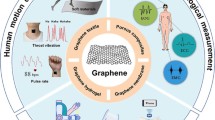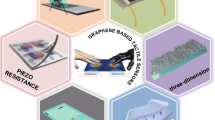Abstract
In this paper, three categories of ECG electrodes were fabricated. Graphene/PDMS(Polydimethylsiloxane)(G-I), Graphene/MWCNT-COOH(Carboxylic-acid functionalized Multi-walled Carbon Nanotubes)/PDMS(G-II),and Graphene/SWCNT-COOH(Carboxylic-acid functionalized Single-walled Carbon Nanotubes)/PDMS(G-III). Each group had thirteen electrodes with varying concentrations ranging from 0.1-5wt%. Since CNTs get tangled easily, it becomes necessary to disperse them properly. To achieve optimal dispersion, CNTs were first sonicated with Isopropyl Alcohol (IPA), and then with PDMS. Mold casting was the technique used for fabricating the electrodes. The results were compared with the conventional ECG electrodes. Best results were achieved from G-III at 3wt% as the value of capacitance is high (0.172nF) as compared to G-I and G-III values at 3wt% which are 0.036nF (0.036nF) and 0.015nF respectively. As capacitance has an inverse relationship with the resistance and impedance, thus at 3wt% the resistance (0.361MΩ) and impedance (0.36MΩ) values are low, which satisfies the relationship. The values of resistance and impedance of G-II are low when compared with the values of G-I and G-II. Great results and ECG waveform are achieved with 3wt% for G-II, which also uses less nanomaterials to produce such great ECG results. It was observed that even after using the electrodes for 5 days, the ECG signal did not degrade over time and no skin allergies were detected for any of the three groups. The ECG tracking system was developed on the concept of the Internet-of-Things (IoT) using various electronic hardware components and software solutions. The results from the fabricated electrodes were promising and were suitable for long-term, and continuous ECG monitoring.













Similar content being viewed by others
References
J.Y. Baek, J.H. An, J.M. Choi, K.S. Park, S.H. Lee, Flexible polymeric dry electrodes for the long-term monitoring of ECG. Sens. Actuators. A. Phys. 143, 423–429 (2008). https://doi.org/10.1016/j.sna.2007.11.019
B. Gandhi, N.S. Raghava, Fabrication Techniques for Carbon Nanotubes Based ECG Electrodes: A Review. IETE. J. Res. (2020). https://doi.org/10.1080/03772063.2020.1768909
M.F. Hossain, J.S. Heo, J. Nelson, I. Kim, Paper-Based Flexible Electrode Using Chemically-Modified Graphene and Functionalized Multiwalled Carbon Nanotube Composites for Electrophysiological Signal Sensing. Information. 10(10), 325 (2019). https://doi.org/10.3390/info10100325
H.C. Jung, J.H. Moon, D.H. Baek, J.H. Lee, Y.Y. Choi, J.S. Hong, S.H. Lee, CNT/PDMS composite flexible dry electrodes for long-term ECG monitoring. IEEE. Trans. Biomed. Eng. 59(5), 1472–1479 (2012). https://doi.org/10.1109/TBME.2012.2190288
J.H. Kim et al., Simple and cost-effective method of highly conductive and elastic carbon nanotube/ polydimethylsiloxane composite for wearable electronics. Sci. Rep. 8(1375), 1–11 (2018). https://doi.org/10.1038/s41598-017-18209-w
T. Kim, J. Park, J. Sohn, D. Cho, S. Jeon, Bioinspired, Highly Stretchable, and Conductive Dry Adhesives Based on 1D–2D Hybrid Carbon Nanocomposites for All-in-One ECG Electrodes. ACS. Nano. 10(4), 4770–4774 (2016). https://doi.org/10.1021/acsnano.6b01355
S.M. Lee, H.J. Byeon, J.H. Lee et al., Self-adhesive epidermal carbon nanotube electronics for tether-free long-term continuous recording of biosignals. Sci. Rep. (2015). https://doi.org/10.1038/srep06074
B. Liu, Y. Chen, Z. Luo, W. Zhang, Q. Tu, X. Jin, A novel method of fabricating carbon nanotubes polydimethylsiloxane composite electrodes for electrocardiography. Biomater. Sci. Polym. E. 26(16), 1–7 (2015). https://doi.org/10.1080/09205063.2015.1082807
J.P. Lu, Elastic properties of carbon nanotubes and nanoropes. Phys. Rev. Lett. 79(7), 1297–1300 (1997). https://doi.org/10.1103/PhysRevLett.79.1297
S. Mallakpour, S. Soltanian, Surface functionalization of carbon nanotubes: fabrication and applications. RSC. Adv. 6, 109916–109935 (2016). https://doi.org/10.1039/C6RA24522F
A. Nag, S.C. Mukhopadhyaya, J. Kosel, Flexible carbon nanotube nanocomposite sensor for multiple physiological parameter monitoring. Sens. Actuators. A. Phys. 251, 148–155 (2016). https://doi.org/10.1016/j.sna.2016.10.023
A. Pantelopoulos, N.G. Bourbakis, A survey on wearable sensor-based systems for health monitoring and prognosis. IEEE. Trans. Man. Cybern. 40, 1–12 (2010). https://doi.org/10.1109/TSMCC.2009.2032660
R.S. Ruoff, J. Tersoff, D.C. Lorents, S. Subramoney, B. Chan, Radial deformation of carbon nanotubes by van der Waals forces. Nature. 364, 514 (1993). https://doi.org/10.1038/364514a0
The Dow Chemical Company, Technical Datasheet (2017). https://www.dow.com/content/dam/dcc/documents/en-us/productdatasheet/11/11-31/11-3184-sylgard-184-elastomer.pdf?iframe=true. Accessed 7 May 2017.
M.-F. Yu, O. Lourie, M.J. Dyer, K. Moloni, T.F. Kelly, R.S. Ruoff, Strength and Breaking Mechanism of Multiwalled Carbon Nanotubes Under Tensile Load. Science. 287(5453), 637–640 (2000). https://doi.org/10.1126/science.287.5453.637
Z. Zhu, An Overview of Carbon Nanotubes and Graphene for Biosensing Applications. Nano. Micro. Lett. 9(25), 1–24 (2017). https://doi.org/10.1007/s40820-017-0128-6
Author information
Authors and Affiliations
Corresponding author
Ethics declarations
Conflict of interests
The authors declare that they have no known competing financial interests or personal relationships that could have appeared to influence the work reported in this paper.
Additional information
Publisher's Note
Springer Nature remains neutral with regard to jurisdictional claims in published maps and institutional affiliations.
Rights and permissions
Springer Nature or its licensor holds exclusive rights to this article under a publishing agreement with the author(s) or other rightsholder(s); author self-archiving of the accepted manuscript version of this article is solely governed by the terms of such publishing agreement and applicable law.
About this article
Cite this article
Gandhi, B., Raghava, N. Graphene and graphene nanohybrid composites-based electrodes for physiological sensing applications. Biomed Microdevices 24, 29 (2022). https://doi.org/10.1007/s10544-022-00630-2
Accepted:
Published:
DOI: https://doi.org/10.1007/s10544-022-00630-2




